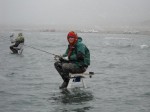 It usually starts in the pre- dawn pitch black. The savvy local fishermen will stake out a prime spot on the beach before the competition arrives. Not every spot is equal. There is a certain amount of rivalry in getting the best slot. In the pure dark, you may exchange unpleasantries with somebody who is a friend in the daylight. It is impossible to tell with the naked eye, but there are depressions out in the sand, or subtle lake currents that may adversely affect your success. With time on the water, you can learn what beaches to fish, and every little spot on a given beach. Team the knowledge of where to fish with what to use, and success is to be expected.
It usually starts in the pre- dawn pitch black. The savvy local fishermen will stake out a prime spot on the beach before the competition arrives. Not every spot is equal. There is a certain amount of rivalry in getting the best slot. In the pure dark, you may exchange unpleasantries with somebody who is a friend in the daylight. It is impossible to tell with the naked eye, but there are depressions out in the sand, or subtle lake currents that may adversely affect your success. With time on the water, you can learn what beaches to fish, and every little spot on a given beach. Team the knowledge of where to fish with what to use, and success is to be expected.
There are certainly better times of the year than others to fish Pyramid from the shore. When the season first opens on October 1rst, and the water temps are in the 70ís, you probably wonít catch many fish from the banks. At that time of year, the few fish that are caught from the banks are usually pulled off beaches that have adjacent deep water. At a beach like Blockhouse or Spider Point, it is possible to make a long cast into 70 feet of water. Unfortunately, you wonít be in the zone for long, and most of the fish landed will be at the beginning of the retrieve. In order to make a long enough cast to get to the deeper water, tossing a big heavy spoon is pretty much mandatory. Spoons are probably the least effective lure on Pyramid. There was a time that they were all that anybody used, but in the 21rst century they have pretty much been forgotten. If you do toss a spoon, good colors are Firetiger, Frog, red with black dots, white with black dots, and orange with black dots. The trick to catching fish on the spoon at Pyramid, and especially big fish, is getting the spoon down to where the big bottom hugging fish live, and then making an enticing retrieve. The best spoon fishermen usually retrieve their spoon in a herky jerky fashion. Itís kind of like horizontal jigging. Lahontan Cutts are notorious followers, and the stop and go retrieve elicits strikes.
In the early fall, some fish will also make daily journeyís into the shallows. They will usually come in during low light conditions. They wonít stay long, but they are there with only one thing on their mindsí, and that is feeding. In November, there always seems to be a movement of large fish into the shallows. The action isnít hot, but there are always some hogs caught. These big fish will come within easy reach of fly fishermen at beaches like the Nets or Pelican. Scores will likely be low, but once again, these fish are aggressively feeding. In fact, if just about any presentation can catch these active fish.
The dead of winter is a hard time to fish the big lake. All but the most stubborn diehards vacate. Maybe you need to be a little "nuts" to stand on a ladder in 43 degree water on a 5 degree morning. Iíve yet to figure out a way to keep my stripping hand from freezing. The best advice is to bring a lot of spare sets of gloves, and wear as much clothing as you can put on. I usually wear two pairs of wool socks, plus my heaviest duty waders, and to top it all off about 4 jackets topped off with a waterproof coat. All the same tactics that catch fish during the fall will work during the winter, but the fishing usually is most reliable off the deep beaches. During December, January, and most of February, the best beaches tend to be the same ones that produce when the weather is hot. Beaches like Blockhouse, Wino, Sand Hole, and Spider Point produce big fish all winter long. The fishing is usually pretty slow. In fact, your odds of a skunk are fair. The funny thing is, every once in a while somebody has a good day where they land 20 fish topped off by several good quality fish. It just proves you canít catch fish if youíre not fishing.
while somebody has a good day where they land 20 fish topped off by several good quality fish. It just proves you canít catch fish if youíre not fishing.
Depending on the year, spring fishing conditions may start as early as mid February or as late as early April. If it has been unusually cold during the winter, spring conditions may take a long time to get going. It is always nothing short of a crap shoot when it comes to forecasting the start of "good fishing." There are too many factors, and the best way to find out is by checking as many reports as you can find. Every week of the year, there will be ladder fishermen on the lake. Fishermen being "chatty Cathyís" by nature will surely spread news of their fishing fortune or misfortune. When the reports seem to be consistently good, itís time to take a gamble and make your way to the lake. Without question, if a traveling angler wants quality fishing on Pyramid Lake, March or April are the months to come. A good mix of quality and quantity can be expected, and the weather is more likely to be hospitable than January. The fish are generally in shallow water and very accessible to fishermen. There are two major downfalls to spring fishing. The first hurdle is the crowds. You can expect a lot of people to be on the water, and it can get very competitive on the better beaches. You can beat the crowds by fishing no name beaches, but donít expect high scores. Usually, the crowd is there for a reason. The second problem can be getting the fish to bite. These fish are in the shallows not for purpose of feeding. Theyíve got one thing on their mind; reproduction. It is really amazing that they still feed while in spawn mode. Many salmonidís just shut down until they are done, but Lahontan Cutts generally keep feeding.
What To Use
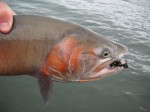 For decades, fly fishermen have been trying to figure out the best way to get their fly to the bottom. In fact, it is way more important that your fly be on the bottom than what fly you use, as long as you are in the right general scheme of things. In the old days, guys were splicing leadcore line to their fly lines to get to the bottom. I canít imagine how that cast. These days, there are all kinds of fly lines available that will get your fly to the bottom. Some guys are partial to full sinking lines, while others prefer shooting head lines with a fast sinking tip and a floating mainline. I have used both, and I donít really care what the line is as long as it gets down quick and stays down. It also needs to cast well, and punch a double fly rig into Pyramidís notorious winds. The line I use is made by Rio and is called "Streamertip." It casts well, and it sinks quickly. Of course, some of the old pros have their own custom made lines that are a combination of several components that outperform commercially available lines, but for all practical reasons, "Streamertip" is a good choice. The other "donít do" when it comes to Pyramid rods and lines is coming under gunned. Donít show up with a 6 weight for stripping. It just doesnít have the guts to toss a two fly rig into the wind. Plus, you canít toss the heavier grained sinking lines that get down quickly. Personally, I think an 8 wt. is ideal, and I would even consider using a ten weight in some circumstances.
For decades, fly fishermen have been trying to figure out the best way to get their fly to the bottom. In fact, it is way more important that your fly be on the bottom than what fly you use, as long as you are in the right general scheme of things. In the old days, guys were splicing leadcore line to their fly lines to get to the bottom. I canít imagine how that cast. These days, there are all kinds of fly lines available that will get your fly to the bottom. Some guys are partial to full sinking lines, while others prefer shooting head lines with a fast sinking tip and a floating mainline. I have used both, and I donít really care what the line is as long as it gets down quick and stays down. It also needs to cast well, and punch a double fly rig into Pyramidís notorious winds. The line I use is made by Rio and is called "Streamertip." It casts well, and it sinks quickly. Of course, some of the old pros have their own custom made lines that are a combination of several components that outperform commercially available lines, but for all practical reasons, "Streamertip" is a good choice. The other "donít do" when it comes to Pyramid rods and lines is coming under gunned. Donít show up with a 6 weight for stripping. It just doesnít have the guts to toss a two fly rig into the wind. Plus, you canít toss the heavier grained sinking lines that get down quickly. Personally, I think an 8 wt. is ideal, and I would even consider using a ten weight in some circumstances.
The other must have fly rod setup is a 6 weight rod with a floating line. Basically, the rod that you would use on your favorite trout stream will suffice. In the last five years, "indicator fishing" has taken the lake by storm. I have bad mouthed indicator fishing a lot because it seems illogical that big meat eating fish would want anything to do with a midge larva, but every year big fish are caught on nymphs under an indicator. Sometimes, thatís the only thing the fish will eat. I will go ahead and say that far fewer big fish are caught on indicator rigs, but it is certainly a worthy trick to have in your arsenal. My big complaint is that if you are lucky enough to get a big fish on a nymph, you will have your hands full trying to land it on a size 10-14 hook. A big tip for nympherís is to tie your patterns on oversized hooks. These fish are meat eaters, and they donít mind oversized flies. I like a size 10 midge pattern, or a general attractor nymph like a Prince Nymph. The big bonus to having an indicator rod is that it is easy fishing. There is a lot less casting when it comes to nymphing than popping a jig.
Whereís the Beef?
So okay, enough of all this wimpy fly fishing talk... what about some meat and potatoes? Surely a guy can catch fish on a non "sissy stick?" Yes, you donít need to be a fly fisherman to have success at Pyramid. In fact, the most deadly trophy fish lure on the lake isnít a fly, it isnít a Flatfish or a Lyman, itís not a spoon or an Apex, itís the marabou jig. "What, youíre kidding me right?" You say. Iíll stand by that statement. More big fish are caught out of Pyramid on a shore casted marabou jig than by boaters or fly fishermen. You could even narrow that statement down to "more big fish are caught on a black marabou jig than any other lure." Black marabou jigs imitate a primary winter food source; leeches. When the chubs disappear in winter and sulk in the lakes depths, the trout start looking for leeches. The black marabou jig is the ultimate strike elicitor. Its major advantage over the fly is its rapid rising and falling motion. Iíve never seen a leech haul butt like a ľ ounce jig, but the fish sure do like it. The absolute key to fishing the jig is getting the proper retrieve. If you crawl the jig over the bottom, chances are you wonít catch many fish. The fish usually like the jig "popped" in rapid lifting motions. The lift isnít quite like setting the hook, 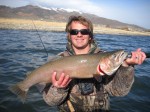 but itís a pretty rapid rise. The key is experimentation. Keep playing with your retrieve until you get bit. The big problem with the jig versus the fly is that you miss a lot of strikes. It is impossible to hook every fish that bumps the jig. Once you get the right rhythm, it can really be surprising how many grabs this can produce. Just cast your jig as far as you can, and then pop it all the way back to your feet. Iíve had fish literally come out of the water as I pulled the jig out for another cast. Tie your jigs on high quality heads and hooks. I use either 1/0 or 2/0 hooks for ľ ounce. There are times where you may want to downscale to 1/8th ounce, and you are more likely to be using a size 1/0 or 2 hook.
but itís a pretty rapid rise. The key is experimentation. Keep playing with your retrieve until you get bit. The big problem with the jig versus the fly is that you miss a lot of strikes. It is impossible to hook every fish that bumps the jig. Once you get the right rhythm, it can really be surprising how many grabs this can produce. Just cast your jig as far as you can, and then pop it all the way back to your feet. Iíve had fish literally come out of the water as I pulled the jig out for another cast. Tie your jigs on high quality heads and hooks. I use either 1/0 or 2/0 hooks for ľ ounce. There are times where you may want to downscale to 1/8th ounce, and you are more likely to be using a size 1/0 or 2 hook.
Braided line is pretty much a must for good jig fishing. Not all braids are created equal. The great test is how they lay down on a reel spool. The way you pop the jig will result in constantly retrieving slack line. Some braids donít perform well in a slack state. I personally use Spiderwireís Red Braid. I like the Hi-Vis braids because I donít always feel the strike, and every hundredth strike I catch a fish because I saw my line move. I use an Albright Knot to attach a ten foot section of ten pound Maxima Ultragreen for my leader. Some guys insist on fluorocarbon, but in my experience Cutthroats are pretty dumb when it comes to line shyness. There is no reason you need to use 10 Lb, you could go as heavy as 15 with no problem.
Ladder Etiquette
Most ladder fishermen are good guys, and as long as you practice common courtesy youíll be okay. As long as you donít setup too close to somebody, youíll likely have no problems. How close is too close depends on the situation. If you are on an uncrowded beach and setup within 20 yards of somebody, that may be too close. If you are on a crowded beach, 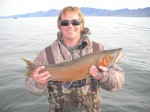 and there is room for your neighbors to comfortably cast, that may be acceptable. Ask your neighbor and feel them out. If they seem cantankerous, you probably donít want to fish that close to them.
and there is room for your neighbors to comfortably cast, that may be acceptable. Ask your neighbor and feel them out. If they seem cantankerous, you probably donít want to fish that close to them.
If you want a prime position at Pelican or the Nets, you had better plan on getting there early to set your ladder. You canít expect to have a spot as your own until you put your ladder on it. Sitting in your truck thatís parked where you want to fish doesnít count. So, get out early and stake out a prime position. Once again, not all spots are as good as the next. Only time on the water can tell you whatís best.
Bring a big net! Bring whatever net you would want to use on fish that may be over 15lbs. Lots of guys donít even bring a net... what are they thinking?
Ladders
There are as many different ladders in use as there are fishermen on the lake. It can look like a band of traveling gypsies has taken up residence in four feet of water. There can be a real variety of wading essentials in the water.
Pretty much any ladder will work, and some guys have a distinct preference for one or the other. I have a custom made platform that is hard to beat. It has a big platform to stand on, and a nice soft chair to rest my tookus on when Iíve stood for a few hours. If Iím not using my casting tower, I like a 6 ft. A-Frame ladder. A 6 footer gets you a out of the water sufficiently high to make good casts and keep you dry. An 8 footer is too cumbersome. Some guys like step ladder style ladders, but Iím not personally a big fan.
Whatís a Fishing Story Without Some Good Anecdotes?
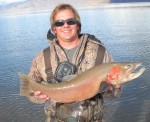 Iíll start off by saying, Iíve been skunked my fair share of times. Nowadays, Iím always confident that Iíll catch fish, and I will likely catch a nice fish over 5Lb for a day of shore fishing.
Iíll start off by saying, Iíve been skunked my fair share of times. Nowadays, Iím always confident that Iíll catch fish, and I will likely catch a nice fish over 5Lb for a day of shore fishing.
So how good can it be? On March 3rd, I hit the lake at o-dark-thirty, and started casting in the dark. I popped my jig twice and it was inhaled by a hungry "rat cutt." The "rat cutt" is the puny 17-20" schoolie sized fish. You know youíre spoiled when 17-20" is a "rat." By the way, they fight pretty danged good on a spinning rod or a fly rod. For the next 13 casts, I landed a fish on every single cast. It was just getting light enough to see when I whiffed on fish number 15. Talk about spoiled, I had just landed 14 fish in a row and was unhappy because I muffed on fish 15Ö and 16. Sixteen casts with sixteen consecutive fish landed. I wound up landing 22 fish before the sun even hit the water. Of course, this article is about trophy trout, and about a half hour after the sun rose, the little rat fish got pushed out by some fish that would eat them if they had the chance. When the little fish disappear, there is a fair chance that the bite hasnít actually died, but the biterís have changed. My neighbor to my right caught the first nice buck; a fish in the 6Lb range. That was a good indication that something had changed. Until that point, the fish had mostly been small hens. About 5 minutes later, I got a nice 5Lb buck. Merely ten minutes later, I was popping my beat up jig in when I feel the jig get inhaled. I set hard, and a very large cutthroat is easily visible in the clear water. I would love to tell you how it ripped me up and tore drag off, but anybody who has caught big fish knows they donít all do that. He made one or two short drag pulling runs, and I jumped off my ladder, grabbed my net and drug him into shallow water where I could easily land him. What a beauty of a fish he was, just a smidgen under 10Lbs on a Boga and a digital.
So I was feeling pretty good about that. Nearly a half hour went by, and once again I feel a tap. I set hard, and this time, this fish doesnít want to be landed. This fish was a true athlete of the cutthroat world. He made several good runs, and then dug in bulldogged side to side. I could have sworn he was over ten in the water, and with good reason, he was 30"+, but he was a little skinny. This fish went 9.5lbs, but he had a lot more spunk than his almost ten pound pal.
I wound up with 35 + fish that day. Several of those fish were over 5Lbs, one was just short of ten, and another was 9.5Lbs. That is a dream day on Pyramid, but days like that are regularly possible if you pay your dues and give it a try.
Best of luck,
Mike